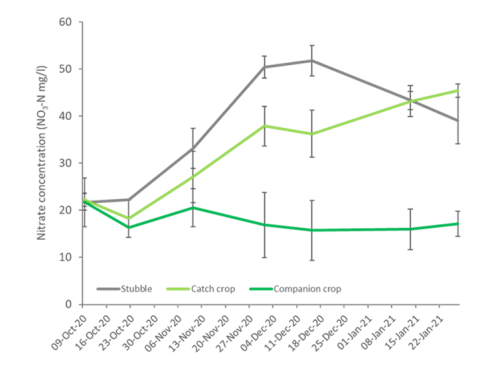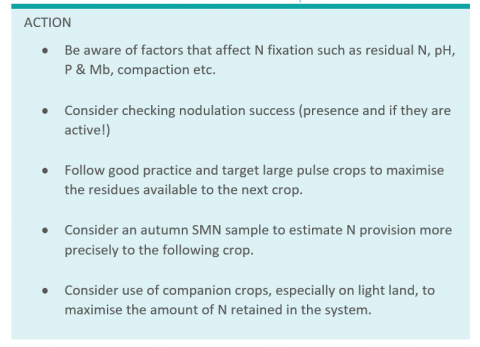Thomas Wilkinson, Charlotte White & Pete Berry
Maximising N Provision from Pulse Crops
In the context of increased N fertiliser prices and efforts to minimise C footprints of food production, it is worth considering how to maximise biologically fixed N from pulse crops and its provision to other crops in the rotation. It should also be remembered that pulse crops can provide other rotational benefits such as soil texture and health improvement, weed control opportunities, slug control and opportunity to spread the workload.
RB209 recommends reducing N fertiliser application to crops following pulses by 30 kg N/ha, similar to crops following OSR, potatoes or fallow. AHDB Report 490 attempted to measure the soil nitrogen supply (SNS) of fields following pulse crops by measuring the “harvested SNS” of following crops (harvested SNS = the final crop N uptake of the unfertilised crop). Figure 1 shows the RB209 predicted SNS vs harvested SNS for crops following beans. The steep best fit line indicates that RB209 is underestimating the amount of N available for crops following beans. RB209 estimates for peas were more reflective of the final harvested SNS.
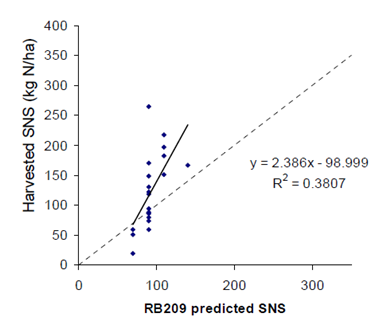
Figure 1. Harvested SNS (the final crop N uptake of the unfertilised crop) of crops following bean crops vs the predicted SNS calculated from RB209. From AHDB Report 490
There is likely to be variation of the final amount of N provided to following crops based on genetic, environmental or other factors. Pulse crops may take up some N directly from the soil. The amount of additional N provided by pulses to the following crop is determined by the amount of N fixed by the pulse crop and what remains in the system after N offtake from the seed at harvest, any removal of N containing residues such as straw offtake, losses to the system during crop growth (e.g. turnover of roots and nodules), losses resulting from the turnover of crop residues after harvest e.g. from breakdown of residues and turn over through the nitrogen cycle. The remainder of the article explores some of these points.
N fixation by pulses and factors that affect it
The amount of nitrogen that a pulse crop fixes is typically around 150 to 240 kg N/ha and could be >300 kg N/ha. Factors that affect N fixation are:
- Soil mineral N
- Typically, 50-60% of the total N uptake for a pulse crop is from biologically fixed N (70-80% in forage legumes).
- This can be reduced to 35-50% total N uptake from fixed N when SMN is high (200-250 kg N/ha).
- pH
- N fixation is sensitive to low pH (<5.5). pH 6.5 is optimal.
- Temperature
- N fixation is most effective when soil temperatures are between 7°C and 20°C.
- N fixing nodules develop 3-5 weeks after plant emergence.
- Phosphorus and molybdenum
- Ensure adequate supplies.
- Sunlight
- N fixation requires lots of energy and uses about 30% of energy captured by the plant.
- Other
- Dry soil, compaction and salinity can impact N fixation.
Nodulation can be assessed at flowering in pulse crops. If you plan to do this dig up the roots carefully and soak them in water to gently remove the soil so that the nodules do not break off. Nodules with pink interiors are healthy and are fixing N.
N containing residues from pulses
Using standard values for yield, seed protein percentage and N harvest index and assuming straw is incorporated, it is estimated that pea and bean crops could return around 43-45 kg/ha N to the soil from above ground residues after harvest. These standard values can be compared to values measured from the pulse YENs which provide a similar estimation (Table 1).
Table 1. Estimations of N returned to the soil from above ground pulse crop residues for combining pea and field bean crops. Estimations are based on UK averages and standard values, or values derived from the Pulse YEN database.
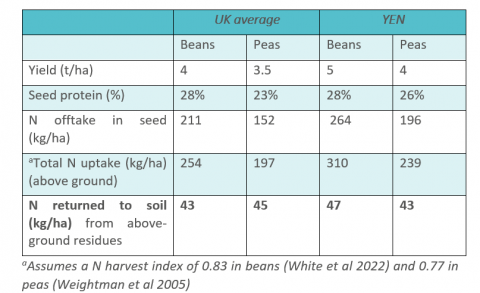
The amount of N provided by below ground residues is harder to measure and less well understood but will also contribute to the N provided by a pulse crop.
Maximising residues in the system
Data analysis of pulse YEN crops from 2018-2022 highlights a strong association of yield and above ground biomass for both combining peas and field beans (Figure 4, Table 2).
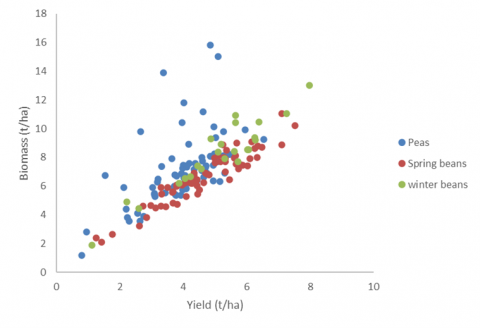
Figure 2. Above ground biomass (t/ha) vs yield (t/ha) of pulse crops analysed via the Pea YEN and Bean YEN from 2018-2022.
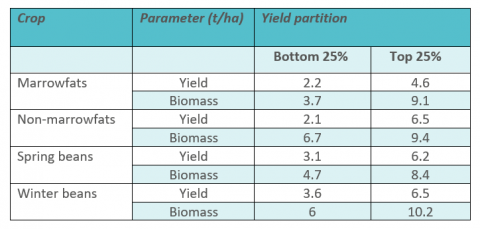
Assuming that there is no dilution effect of plant residue N concentration with increased yield and biomass in pulse crops, one strategy to increase N containing residues is to grow large crops. This may also have the added benefit of being associated with targeting high yields. Recent crop reports and stormy weather has highlighted the importance of standing of pulse crops which should not be overlooked. More information on parameters associated with high yielding pulse crops in the YEN data set can be found on the YEN website and further information on good practice for growing pulse crops can be found on the PGRO website
Maintaining N within the system
Like N residues from other previous crops, N from pulse crops can be lost over the winter and this may be increased on light land. An Anglian Water funded project investigated the impact of catch (destroyed 1st October) and
companion cropping after a vining pea crop on a sandy loam soil site. It was found that a companion crop of buckwheat, linseed, phacelia, sunflower, crimson clover and red clover reduced winter nitrate leaching between October and January (Figure 5), suggesting that companion crop helped retain N in the system.
